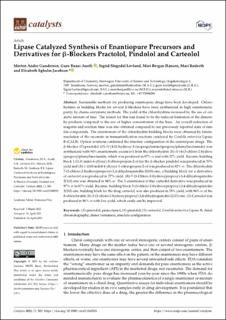| dc.contributor.author | Gundersen, Morten Andre | |
| dc.contributor.author | Austli, Guro Buaas | |
| dc.contributor.author | Løvland, Sigrid Sløgedal | |
| dc.contributor.author | Hansen, Mari Bergan | |
| dc.contributor.author | Rødseth, Mari | |
| dc.contributor.author | Jacobsen, Elisabeth Egholm | |
| dc.date.accessioned | 2022-11-02T07:55:29Z | |
| dc.date.available | 2022-11-02T07:55:29Z | |
| dc.date.created | 2021-06-21T16:06:29Z | |
| dc.date.issued | 2021 | |
| dc.identifier.citation | Catalysts. 2021, 11, 503-518. | en_US |
| dc.identifier.issn | 2073-4344 | |
| dc.identifier.uri | https://hdl.handle.net/11250/3029478 | |
| dc.description.abstract | Sustainable methods for producing enantiopure drugs have been developed. Chlorohydrins as building blocks for several β-blockers have been synthesized in high enantiomeric purity by chemo-enzymatic methods. The yield of the chlorohydrins increased by the use of catalytic amount of base. The reason for this was found to be the reduced formation of the dimeric by-products compared to the use of higher concentration of the base. An overall reduction of reagents and reaction time was also obtained compared to our previously reported data of similar compounds. The enantiomers of the chlorohydrin building blocks were obtained by kinetic resolution of the racemate in transesterification reactions catalyzed by Candida antarctica Lipase B (CALB). Optical rotations confirmed the absolute configuration of the enantiopure drugs. The β-blocker (S)-practolol ((S)-N-(4-(2-hydroxy-3-(isopropylamino)propoxy)phenyl)acetamide) was synthesized with 96% enantiomeric excess (ee) from the chlorohydrin (R)-N-(4-(3-chloro-2 hydroxypropoxy)phenyl)acetamide, which was produced in 97% ee and with 27% yield. Racemic building block 1-((1H-indol-4-yl)oxy)-3-chloropropan-2-ol for the β-blocker pindolol was produced in 53% yield and (R)-1-((1H-indol-4-yl)oxy)-3-chloropropan-2-ol was produced in 92% ee. The chlorohydrin 7-(3-chloro-2-hydroxypropoxy)-3,4-dihydroquinolin-2(1H)-one, a building block for a derivative of carteolol was produced in 77% yield. (R)-7-(3-Chloro-2-hydroxypropoxy)-3,4-dihydroquinolin-2(1H)-one was obtained in 96% ee. The S-enantiomer of this carteolol derivative was produced in 97% ee in 87% yield. Racemic building block 5-(3-chloro-2-hydroxypropoxy)-3,4-dihydroquinolin-2(1H)-one, building block for the drug carteolol, was also produced in 53% yield, with 96% ee of the R-chlorohydrin (R)-5-(3-chloro-2-hydroxypropoxy)-3,4-dihydroquinolin-2(1H)-one. (S)-Carteolol was produced in 96% ee with low yield, which easily can be improved. | en_US |
| dc.language.iso | eng | en_US |
| dc.publisher | MDPI | en_US |
| dc.rights | Navngivelse 4.0 Internasjonal | * |
| dc.rights.uri | http://creativecommons.org/licenses/by/4.0/deed.no | * |
| dc.title | Lipase Catalyzed Synthesis of Enantiopure Precursors and Derivatives for β-Blockers Practolol, Pindolol and Carteolol | en_US |
| dc.title.alternative | Lipase Catalyzed Synthesis of Enantiopure Precursors and Derivatives for β-Blockers Practolol, Pindolol and Carteolol | en_US |
| dc.type | Peer reviewed | en_US |
| dc.type | Journal article | en_US |
| dc.description.version | publishedVersion | en_US |
| dc.source.pagenumber | 503-518 | en_US |
| dc.source.volume | 11 | en_US |
| dc.source.journal | Catalysts | en_US |
| dc.identifier.doi | 10.3390/catal11040503 | |
| dc.identifier.cristin | 1917433 | |
| cristin.ispublished | true | |
| cristin.fulltext | original | |
| cristin.qualitycode | 1 | |

